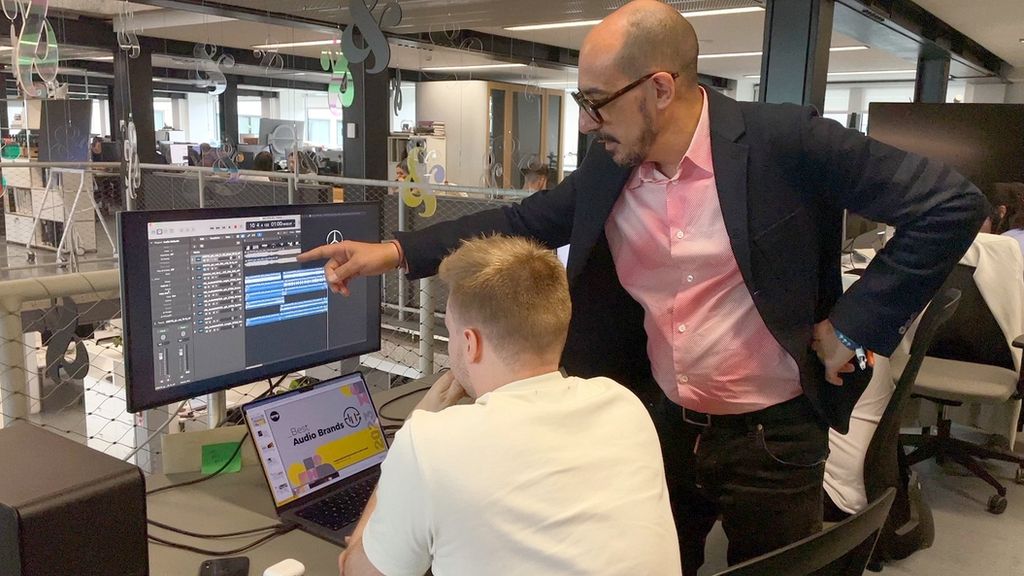AI and sound - helping firms build their own 'sonic identity'

It's widely recognised that we are bombarded with fast-paced imagery in the modern world, whether it's social media videos, or digital billboards in city spaces. But there has been a similar explosion in sound, says advertising entrepreneur Michele Arnese. He thinks brands can only compete with the help of artificial intelligence (AI).
"More and more the sound of a brand is like liquid," says Arnese. "It goes everywhere and takes its shape according to the customer experience."
Only AI, he argues, allows sound to shape-shift this way in our fast-paced, digitally connected world.
Arnese founded the AI-centred music company Amp in Munich in 2009. It was recently acquired by Landor & Fitch, part of the WPP advertising group.
Amp uses AI to generate all kinds of sounds for companies, from small bursts of noise when an app launches, to the sound of a bank card transaction completing, to longer compositions for things like podcasts and social media videos. This is what he calls a brand's "sonic identity".
The internet has been flooded recently with examples of what AI can do, including reimagined films (Harry Potter with muscle-bound characters), new music using the voices of deceased artists like Amy Winehouse or Kurt Cobain, or radical architectural drawings.
So what can AI do for sound in the world of advertising?
Firstly, humans still have a vital role to play in the process, reassures Arnese, whose company is one of the leaders in the field. His in-house composers begin by creating a track known as the "Sonic DNA" of the brand, which might last about 90 seconds.
Listen: An example of 'Sonic DNA' that Amp composed for a finance firm, in order to generate AI-powered branding
AI's first role is to check that this is not similar to sounds already used by other companies. Machine learning can also check whether the signature patterns in the music are likely to have impact and be memorable.
But once this DNA is established, the key role of AI is to allow companies to make music on an industrial scale, explains Arnese, to satisfy digital outlets.
AI can generate potentially infinite music remixes from this DNA, with different tempos, moods and durations, depending on the context, be it a TikTok video, the noise of an appliance coming to life or the intro music for a podcast. Humans check each result before they are put before the public.
Listen: An example of music used for branding generated by AI, using 'Sonic DNA'
The argument for using AI is that this is easier and cheaper than a human selecting and buying individual pieces of production music for thousands of different scenarios.
It also creates computer-orchestrated brand consistency.
In a world of in-app payments and contactless transactions, even the shortest blasts of sound are increasingly important for consumers, says Arnese, because they establish trust and forge the brand's identity.
Arnese is from Italy and studied clarinet in a conservatory, and then IT at the University of Pisa, with an interest in machine learning. After graduating he moved to Germany to work as a management consultant.
Fearing that music would no longer be part of his life, he quit his corporate job to set up his digital agency focused on his first passion, music. It was difficult to persuade brands that they needed to invest in music to begin with, he says, but that has completely changed in the last few years. In the old days big companies might produce just one or two video adverts for TV a year.
"These days no brand is on mute," says Arnese. "Some brands upload a hundred videos to YouTube every week, and we asked ourselves, how can they afford it?"
Some scepticism still remains about whether AI really is a "gamechanger" for the advertising industry, though.
"People put a lot of money into things like the Metaverse, crypto and NFTs, all the things marketers got excited about, and now they've had to backtrack," cautions Molly Innes of Marketing Week.
As a result many people in the advertising world are taking the wait-and-see approach with AI, she says, especially as there is less money going round at the moment to invest in it.
Arnese believes AI will have a profound impact on advertising. However, he doesn't think it will lead to the significant job losses some fear.
"AI is just another tool to do your job," he says.
"It presents an opportunity to be inspired by something unexpected [that the computer generates] in the creative process, that's how I use it.
"Ten years ago there was no such job as data scientist in the advertising industry, can you imagine? But now it is part of the normal team set up of an agency.
"AI is here to stay, but it's not a replacement for humans."
Follow business reporter Dougal Shaw on LinkedIn
